This ancient civilization has been witness to numerous types of arts that originated from India and grew through the course of thousands of years. These art forms are not only a portrayal of the prehistoric and present history of the country but also prove itself as the finest creation of the artists.
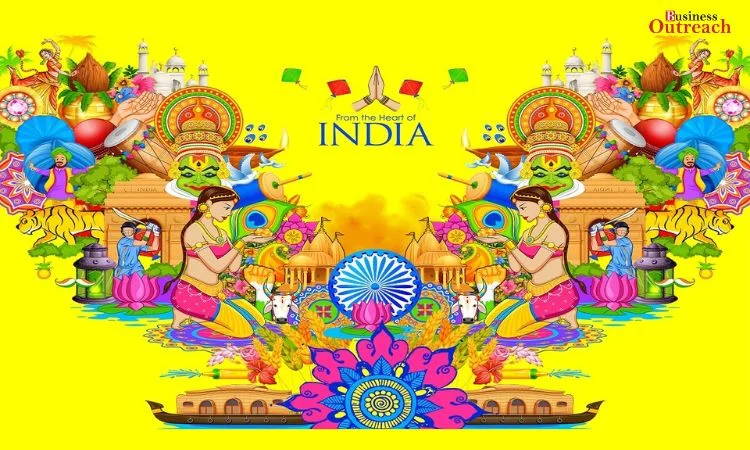
source: Travel Triangle
Here Below The Top 15 Traditional Art Forms Of India
| Art Form | Origin | |
| 1 | Madhubani Painting | Bihar, India |
| 2 | Miniature Painting | 7th century, gained prominence in 16th-17th century during Mughal rule |
| 3 | Warli Painting | Western Ghats, Maharashtra |
| 4 | Pattachitra | 5th-7th century, Odisha and West Bengal |
| 5 | Kalamkari Painting | Andhra Pradesh, India |
| 6 | Phad Painting | Rajasthan, India |
| 7 | Tanjore Painting | 1600 AD, Tamil Nadu |
| 8 | Kalighat Painting | Early 19th century, Kolkata, West Bengal |
| 9 | Gond Painting | Madhya Pradesh, India |
| 10 | Mysore Painting | 18th-19th century, Karnataka |
| 11 | Rajput Painting | 17th-18th century, Rajasthan |
| 12 | Cheriyal Scrolls | Telangana, India |
| 13 | Mughal Painting | 16th-19th century, Mughal India |
| 14 | Pichwai Painting | Nathdwara, Rajasthan |
| 15 | Kerala Mural | 9th-12th century, Kerala |
1. Madhubani Painting- Traditional Art Form of Bihar
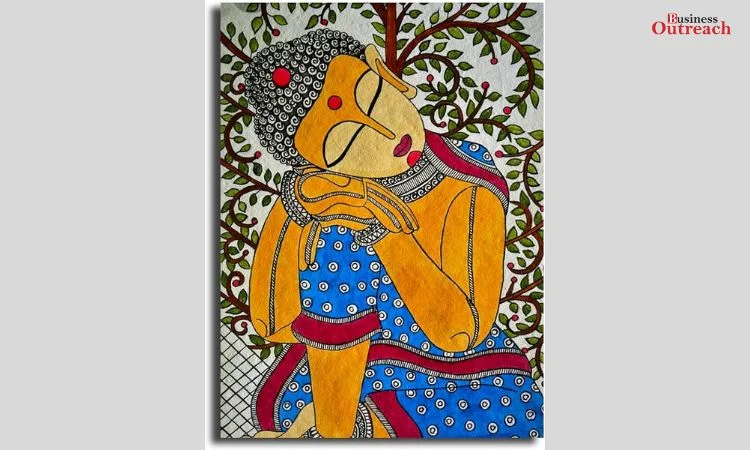
Source: Amazon
Madhubani painting as Mithila painting was developed in the Madhubani district of Bihar state of India and is believed to be one of the oldest and most popular forms of art work in the country. This art of dancing has been passed down as far back as in Satya Yuga that is 1,728,000 years ago and it has been mainly popular among women.
One key aspect of Madhubani paintings is the ability to depict geometric shapes and bright or vivid colours. Some of the most common themes that are frequently depicted include the gods and goddesses of Hindu pantheon, vegetation, and animals. The themes of a common Madhubani painting might include a god or goddess in a setting with flowers and animals, ensuring the artists’ reunion with the divine.
What makes Madhubani paintings different is that even everyday objects are painted with elaborate fretwork and are made with natural dye and pigments. Conventionally, the artists employ such techniques as twigs, brushes, nib-pen and fingers in coming up with these great works of art. Currently, Madhubani art has spread worldwide and is now admired for its simple and elegant artwork that epitomizes spirituality.
2. Miniature Painting- Traditional Art Forms
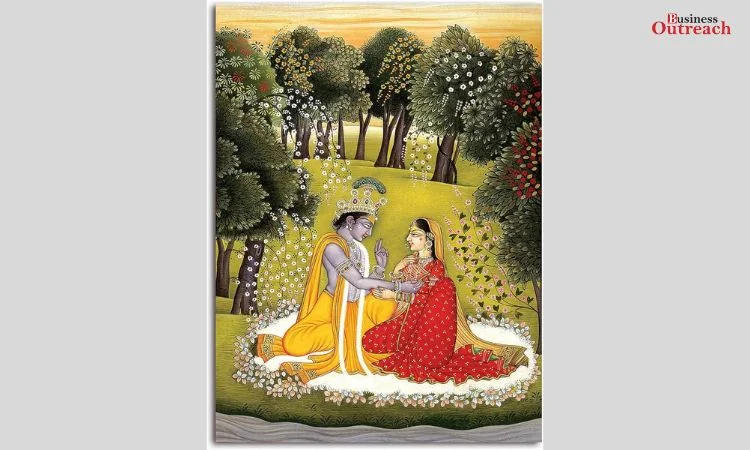
Source: Amazon
As the name suggests miniature paintings are paintings of relatively small size and with a finely detailed appearance. Although the history of this art form is believed to have originated in the 7th century, it got more prominence during the Mughal rule in the 16th and 17th century.
Indian, Persian and Islamic miniature paintings are an exquisite fusion of various blends in art forms. It commonly portrays the episodes which are connected with the royal palaces, hunting, warfare, and stately banquets. Some of these paintings are done with remarkable finesse and compactness; artists used fine brushes to outline elaborate geometric designs and realistic human and animal figures on inconspicuous areas.
In simple terms, there was a progressive change in themes of miniature paintings which reflected elements from Indian mythology and the daily life of people. The splashing of bright colors especially extracted from dukes and metals brings the element of luxury to these pieces. Today, this art still exists and remains popular and trendy and modern artists have adopted new ideas and trends while painting in miniature.
3. Warli Painting- Traditional Art Forms
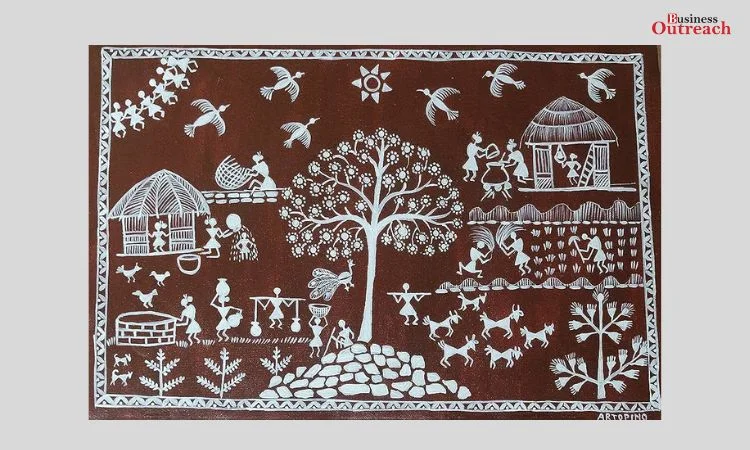
Source: Amazon
Warli painting is one of the oldest forms of paintings in India that include paintings from the period 2500 BC. Warli art is primitive art that hails from the Warli tribe inhabiting the vicinity of western ghats of India particularly in Nashik Thane division of Maharashtra.
In terms of style Warli painting could be described as simplistic where the major iconography included the use of circles, triangles and squares. The artists conventionally employ white paint on earth tones such as on the mud and cloth flooring. The scenes portrayed in the paintings are family events like weddings, economic activities such as farming and hunting, as well as dancing.
What is even more impressive about Warli art, however, is that such simplicity is actually the key to telling rather elaborate stories.. Even though Warli art dates back to around 2500 years ago, it is successfully featured in modern design in various forms such as clothing, accessories, and even home decor.
4. Pattachitra- Traditional Art Forms
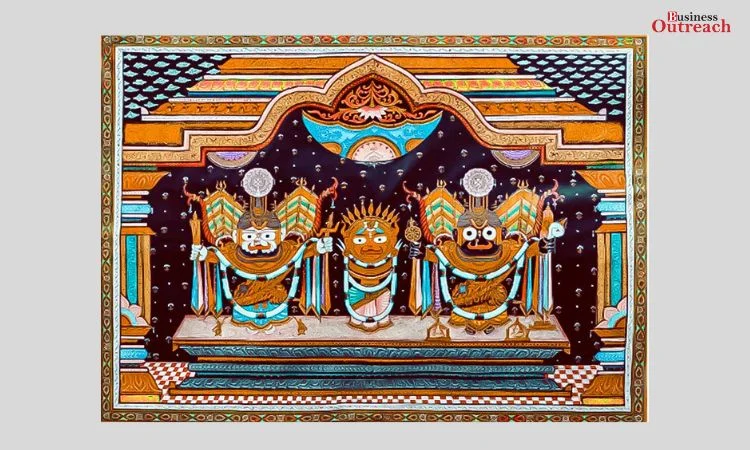
Source: Cottage9
Also called ‘cloth-picture’ in Sanskrit, Pattachitra is a form of painting belonging to eastern India, specifically Odisha and West Bengal. This art form originated in the early middle age; either 5th or the 7th century and is very much associated with the culture and religion of the country.
Such paintings which are Pattachitra paintings are therefore more or less influenced by Jagannath and Vaishnava cult. More often than not, the themes depict and encompass Hindu mythology with specific reference to Lord Krishna and the temple of Jagannath. Just like the small Pattachitra art, the process of how it is made is as fascinating as the art itself. Artists themselves create the canvas by stretching a piece of cloth on which is painted a layer of chalk and gum. Many of the colours used are natural and are sourced from minerals as well as vegetables.
The style boldly outlines the objects based on formal forms, uses a rich palette and features the natural addition of details. The figures are typically depicted with large eyes and elongated limbs that set them apart from more traditional depictions of chimaeras. Over a period of time, Pattachitra has placed its stakes firmly and can be considered as one of the most vibrant parts of Odisha’s art forms.
5. Kalamkari Painting
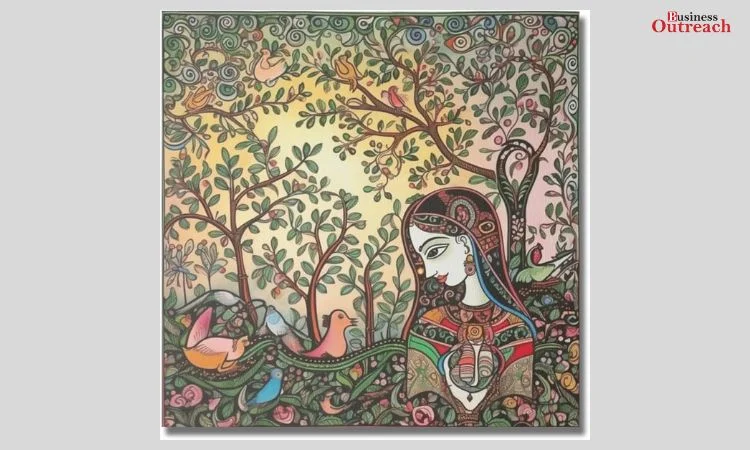
Source: Amazon
This English term literally translates to ‘pen craft’ in Persian, and refers to a type of hand-painted or block-printed fabric which emerged from Andhra Pradesh in India. This art form has two distinct styles: two different styles popular today in Andhra Pradesh – the Srikalahasti style and the Machilipatnam style.
Srikalahasti style of crafts can be made only by hand and it includes the drawings and colours and it mostly focuses on mythological themes. We have already discussed the ‘Machilipatnam style’ as the wooden block printing method. They both are intricate processes involving washing the fabric, applying mordants, applying hand-paint or block-print, and washing the fabric one last time.
The newly developed Kalamkari art works are ornamented using natural dyes derived from plant sources and thus can be classified as environmental friendly art forms. The themes of the art work cover all categories including The Ramayana, The Mahabharata, Flowers and trees, wildlife etc. Modern or contemporary Kalamkari is used as fashion accessories in sarees, kurtas for men and women, dresses and home furnishing.
6. Phad Painting
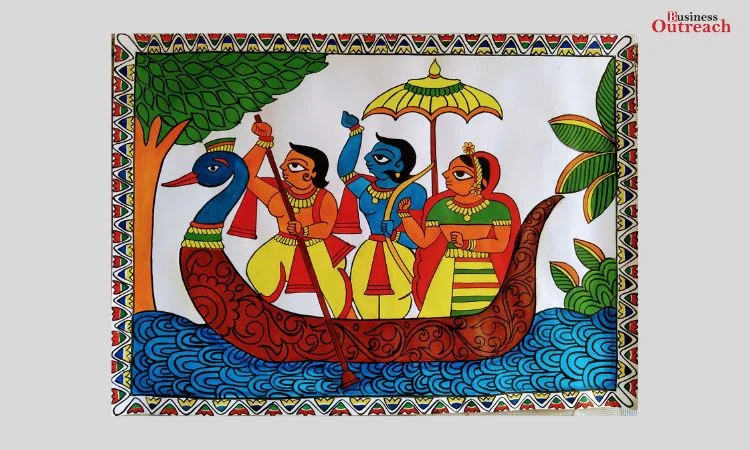
Source: Pinterest
Phad Painting is a type of religious paintings that are made on a scroll, it belongs to Rajasthan state of India. This has been derived from the local word ‘phad’, meaning ‘fold’, to indicate that the paintings are usually done on a long piece of cloth or canvas, which can easily be folded for portability.
These are used to depict the action sequences on the conquests and victories of local gods and goddesses especially Pabuji and Devnarayan. In other words, transitions between sections in this work can be said to be smooth, as if the entire story is painted in sections of a canvas, with different episodes portrayed in different sections of this canvas. The palette is bright, with the colours being red, yellow, and orange primarily taking up the colour scheme.
The use of media or painting in Phad is not all that different from other types of art, it is the narrative component of Phad painting that makes it different. Originally, it was customary for the Bhopas, the priest-singers, to move from one village to another carrying these painted scrolls, and telling the stories painted on top of them. It therefore integrated not only the art type, but also the recording and communication of stories and myths of a given region.
7. Tanjore Painting- Traditional Art Forms
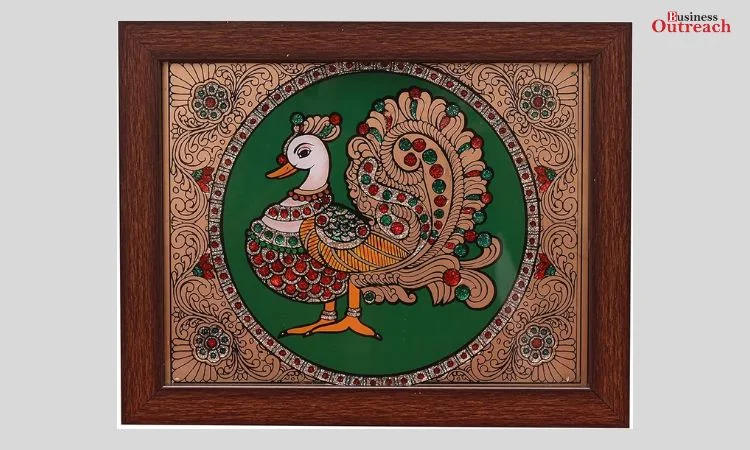
Source: Amazon
Tanjore painting, also known as Thanjavur painting, is said to have originated at Thanjavur district in Tamilnadu after 1600 AD. These art forms had mainly developed during the period of Nayakas of Thanjavur, who took power after the Chola empire.
Tanjore paintings are characterized by splendid colours, ornamented borders with studded stones, and application of gold at various places. Most of the themes are religious; showing Hindu gods, goddesses and saints. The process of making this painting is detailed and entails many steps, from the preparation of the board to the final enhancement.
Tanjore paintings are unique because apart from uses the artists add foal and gems into the painting to give it a three dimensional feel. This serves to provide the paintings a regal and rich appearance, which has in turn placed a lot of value on them. Today, while the subjects and themes have not changed much from historical periods, the Tanjore art paintings depict both conventional motifs and modern concepts.
8. Kalighat Painting
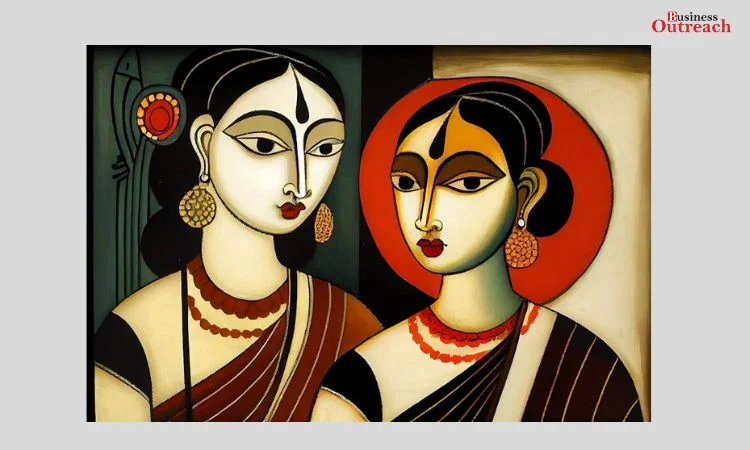
Source: Amazon
Kalighat painting, also known as Bengal Pat, is an early nineteenth-century style developed around the Kalighat temple situated in Kolkata, West Bengal. This art form is a combination of the folklore art originated in India and the new epoch that British rule introduced to the country.
Originally, the focus of Kalighat paintings was religious and depicted gods and goddesses because of their buộc to the temple at Kalighat. However, over time art became a social learning tool where it depicted social issues mostly in a satirical manner. Artists began painting things that portrayed the position of society and politics of that time, and thus Kalighat painting became one of the earliest forms of art that symbolises social protest in India.
As you might have already guessed, the style is more energetic and expressive due to the thick lines and large areas of filled colour, simple shapes and forms. This is in contrast to many other rigid traditional Indian art forms where the compositions seem to be frozen, Kalighat paintings are more dynamic. Now, the kalighat art forms are considered an integral part of the Indian art galleries as many present day artists are found taking ideas from this prominent style of painting and the messages conveyed through it.
9. Gond Painting- Traditional Art Forms
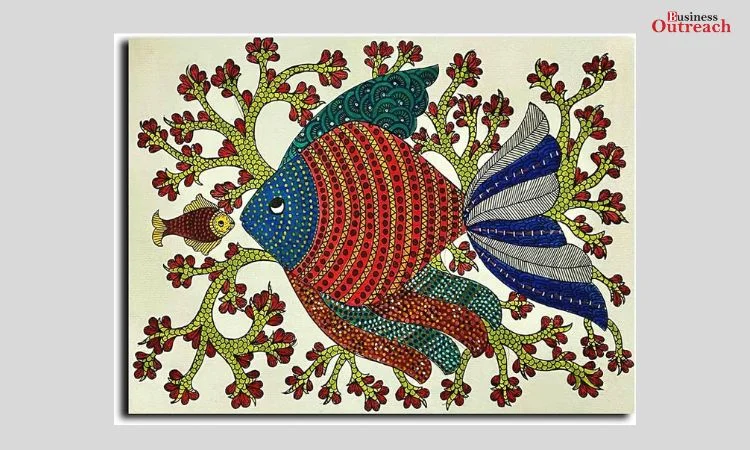
Source: Amazon
Tribal art in India is inclusive of the Gond painting style that belongs to the Gond tribe of Madhya Pradesh. It is about 1400 years old and it is one of the oldest kinds of folk art in India.
Gond paintings primarily depict nature and day to day life and always feature bold and vivacious colours. To make up these larger forms, the artists employ overlapping dots and dashes, and they make the paintings appear lively through this method. Earlier, natural colours were utilised, which were obtained from charcoal, coloured soil, plant juices and sap, leaves and cow dung.
According to their mythology, Gond perform art in a way that they respect this spirit, which is present in everything in nature. Basically, this perspective makes Gond paintings stand out with energy and lively colours which are distinct.
10. Mysore Painting
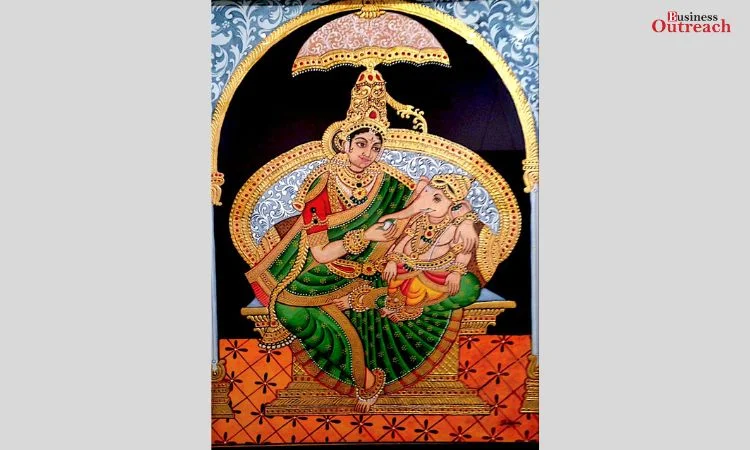
Source: India Mart
Mysore painting is another classic painting originated and nurtured in south India specifically in the kingdom of Mysore patronized by the Wodeyar kings. This art form was in full bloom in the 18th and 19th centuries and Karnataka has been enriched by this unique and delightful form of art.
The Mysore paintings are also famous for their looks, soft and pale range of colours, and final touch work. The themes are mainly spiritual and are portrayed as gods and goddesses, incidents from Hindu mythology. What makes the Mysore painting stand out is the gesso work, a form of raised gilt work which is incorporated in various parts of the painting to enhance the depth of the artwork.
The process of making Mysore painting is quite deliberate and extensive and may take a number of steps right from the preparation of the board, to the final polishing using varnish. The palette is generally dull in most designs, and gold foliage dominates most of the working. Today, though the Mysore painting style is still dear to collectors and distinguished by its refinement, new themes and techniques within the stylistic framework of Mysore are actively explored by contemporary artists.
11. Rajput Painting- Traditional Art Forms
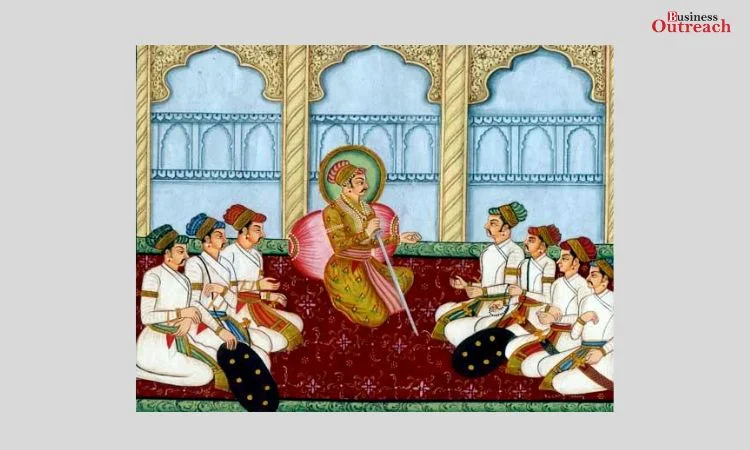
Source: Times of India
Rajput painting or Rajasthani painting is a painting style that originated in Rajasthan and gained popularity between the 17th and the 18th century with Rajput royal families’ support. This type of painting came from the tradition of manus bribe painting in western India but gradually acquired its own features.
According to Rajput paintings the characters have strong lines and they use warm colours with a lot of detail. These themes can include a royal lifestyle, hunting, monarch portrait, and depictions of Hindu mythology and Amaru poetry. In a sense that Rajput painting is quite different from other forms of painting in its ability to capture certain elements of Rajput society and its culture such as its honour, its love, and its mysticism.
The kinds of colours used in Rajput paintings were extracted from minerals, plants and animals, precious stones, and conch shells. Sometimes the gold and silver were added to intensify the whole design or look of the painting. Present day Rajput painting has retained its significance in the art scene of Rajasthan where several artists are in fact influenced by this particular style.
12. Cheriyal Scrolls
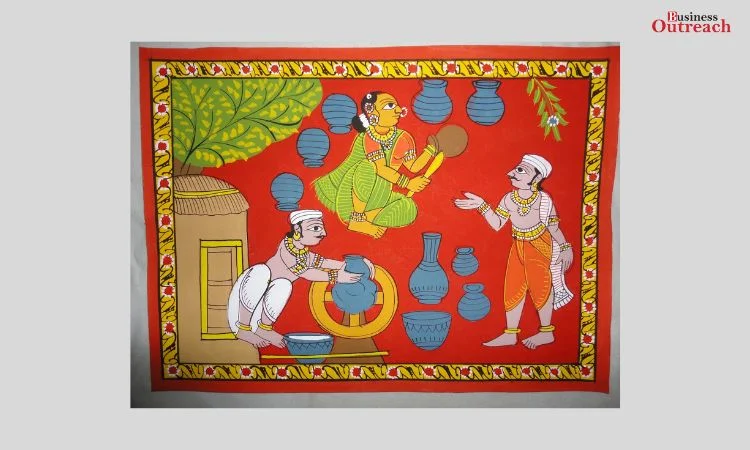
Source: Telengana360
Cheriyal scrolls are a type of painted cloth narrative art forms that have their origin from the Telangana area. This art form inherited from generations of Nakashi family involves use of Kalamkari art, characteristic of the tales of the scroll paintings.
It is also important to note that Cheriyal scrolls are generally known for their finely depicted images and bright colour composition. The scholars estimate that each scroll holds about 50 panels and looks like a contemporary comic strip. These scrolls present typical storylines which are often taken from Hindu epics, the Puranas, and folklore.
What distinguishes Cheriyal scrolls from other forms of textile art is the use of a graphic image to tell the story. In the past, travellers, especially bards who recited stories would use such scrolls, and as a result, they became a crucial element in the oral history society. Modern applications of these scrolls are limited in comparison with the past; however, it can be stated that the practice of this art form persists, and following the examples from the exhibit, it is gradually incorporating itself in modern art and design.
13. Mughal Painting
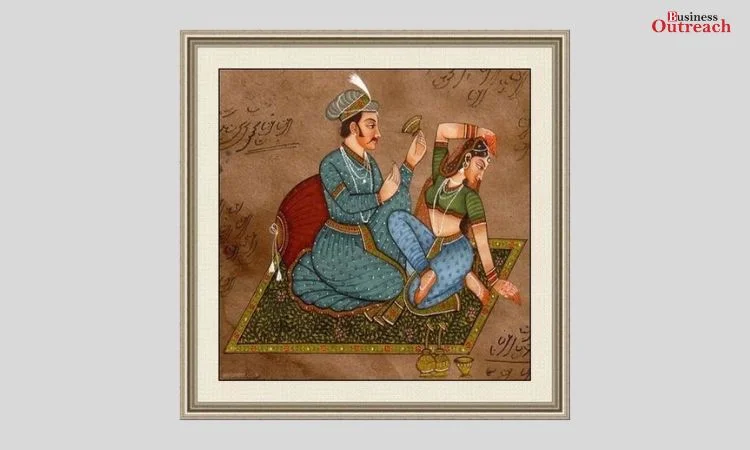
Source: India Mart
The paintings done during the Mughal rule in India and which continued till the 16th to the 19th century are called Mughal paintings and are marked with India, Persian as well as Islamic influences. This art form focuses mainly on miniatures which were made to be used as illustrations of books or as artwork to be enclosed with other pieces in an album.
Some features that are associated with Mughal paintings included very rich details, bright colour resembling jewels, and a certain sense of realism that was quite odd in the later years. They encompass courts and portrait painting, battles and hunt, illustrations of literary texts and more.
Thus, one could note that the specificity of the Mughal painting is in its high technical skills and the syncretism of cultures. The artists used the motifs taken from Persian miniatures, connected them with the Indian trends, and included their imagination. Thus, the Mughal school of painting does not exist today, but its reflections can be observed in many species of Indian and miniature painting that were presented up to the present moment.
14. Pichwai Painting
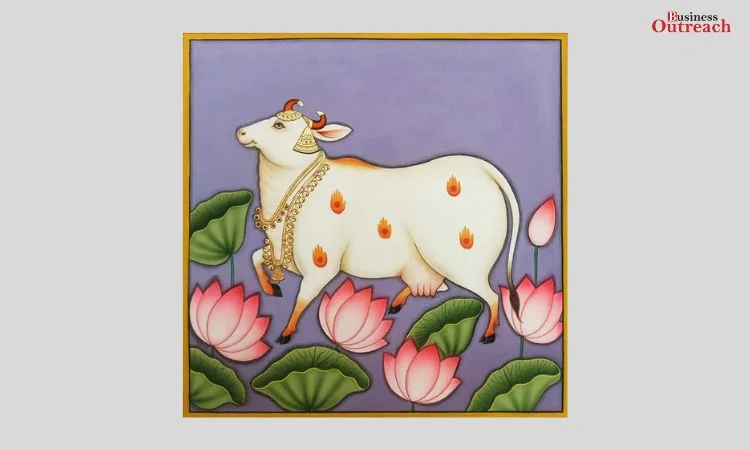
Source: MeMeraki
Pichwai Painting is a traditional art of India and it has its origin in Nathdwara, Rajasthan. The term Pichwai is derived from the hindi language, where ‘pich’ means back and ‘wai’ means hanging and originally was used to depict the elaborate backdrop used behind the ‘murti’ or idol of Shrinathji which is another form of Lord Krishna.
pichwai paintings are usually very detailed, bright and often contain a substantial amount of gold work. The themes shown are based on the stories of Krishna and his early years mostly. Some of them have very rich symbolism and each item depicted in the painting is symbolic and has its own unique meaning.
However, what sets Pichwai apart from other art forms or schools is that it remains deeply linked with worship practices. It’s important to note that these paintings are not only paintings as regular people tend to perceive them but rather they are thought to be a kind of worship. These are hung behind the deity as per the changing seasons and festivals, and hence are used as part of worship or ritualistic practices. Today, although Pichwai forms a major cultural part of the temples, it is also used and displayed in modern homes as a form of wall art.
15. Kerala Mural
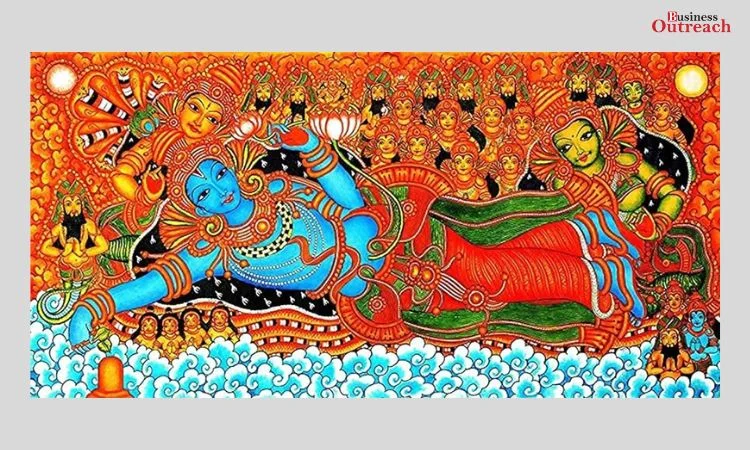
Source: Amazon
Murals are a very colourful art of painting from Kerala which is found in Temple Murals Churches and Palace in Kerala from centuries. This art form was at the highest point between the 9th to the 12th century with the support of different dynasties.
The features of Kerala mural art can be described as increased esterase, the use of the broad stroke, a fund of colours and detailed grain. These themes are primarily mostly drawn from Hindu mythology and specifically the Ramayana and Mahabharata. The most defining characteristic of Kerala murals is the limitation of colour contractions – painters employ only five colours, red, yellow, green, black and white, sourced from natural elements.
It is great to watch a Kerala mural painted and the process may be as interesting as the end result. It requires an intricate process of preparation of the wall surface, tracing the outline, and painting the picture by gradually putting layers of colour. Each of them is significant and is used according to a specific scheme.
Grunting like the Byzantine art, Kerala mural painting had succumbed to a decline due to British colonial rule but had revived in recent years. Even today, this art form is not limited to temple walls but has reached out to elevate the aesthetic of modern houses and other public places and thus preserving this art form for the future generations.
Conclusion
The above 15 art forms are only a small sample of art that is culturally preserved in India, today. Each of the aforementioned art forms has a story to tell — a story of a region, a community, a belief system, or a way of life. They also play the role of providing a look into the various cultures that exist in India and the broader understanding of the nation’s histories and the people’s beliefs.
For those who wish to know more about Indian art, there are several more chances. There are usually organized art walks and art tours in many cities bearing comprehensive information about the art from the city. Take for example the Indian Art Walk, it is a touring agency that provides guided walking tours in Delhi, Agra and Jaipur thus giving tourists a taste of the arts in its cultural environment.
Therefore, Indian art forms are not mere beautiful artefacts’, they are alive, progressing, and constantly drawing from the wellspring of the imagination. It conclusively shows how good art can reflect the country’s history and the continued innovation of its citizens. Whether someone has a passion for art or has other interest in Indian culture, experiencing these art forms presents a unique experience of the artistic world of India.















